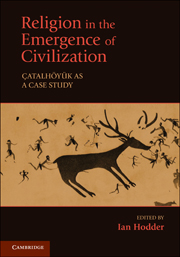Book contents
- Frontmatter
- Contents
- List of Figures and Tables
- Contributors
- 1 Probing religion at Çatalhöyük
- 2 The symbolism of Çatalhöyük in its regional context
- 3 Spiritual entanglement
- 4 Coding the nonvisible
- 5 Modes of religiosity at Çatalhöyük
- 6 Is there religion at Çatalhöyük…or are there just houses?
- 7 History houses
- 8 Marked, absent, habitual
- 9 Temporalities of “religion” at Çatalhöyük
- 10 The Neolithic cosmos of Çatalhöyük
- 11 Magical deposits at Çatalhöyük
- 12 Conclusions and evaluation
- Index
- References
5 - Modes of religiosity at Çatalhöyük
Published online by Cambridge University Press: 05 June 2012
- Frontmatter
- Contents
- List of Figures and Tables
- Contributors
- 1 Probing religion at Çatalhöyük
- 2 The symbolism of Çatalhöyük in its regional context
- 3 Spiritual entanglement
- 4 Coding the nonvisible
- 5 Modes of religiosity at Çatalhöyük
- 6 Is there religion at Çatalhöyük…or are there just houses?
- 7 History houses
- 8 Marked, absent, habitual
- 9 Temporalities of “religion” at Çatalhöyük
- 10 The Neolithic cosmos of Çatalhöyük
- 11 Magical deposits at Çatalhöyük
- 12 Conclusions and evaluation
- Index
- References
Summary
Introduction
Social and cultural phenomena are organized and transmitted in highly patterned ways. Understanding the nature and causes of these patterns can help us to reconstruct some features of prehistoric societies that might otherwise remain undiscovered. The patterns we consider in this chapter concern the relationship between certain features of ritual performance (especially emotionality, frequency and exegetical thinking), on the one hand, and certain features of social morphology (especially the scale, structure and cohesiveness of ancient cults), on the other. We will show that from comparatively fragmentary information concerning the nature of prehistoric rituals at Çatalhöyük we can infer a surprisingly rich picture of how religious knowledge may have been constituted, transmitted and transformed over the lifetime of the settlement and how ritually based coalitions formed, interacted and changed. Our aim is to use a broad understanding of modes of religiosity to throw light on the evidence from Çatalhöyük and to open up discussion of some of the causal links between ritual performance and social and political structure at the site. By combining broad anthropological understanding with the specific data from Çatalhöyük, we believe that some interpretations can be shown to be more plausible than others.
The theory of modes of religiosity
The patterns we seek to investigate at Çatalhöyük stem from two rather different ways of conducting and experiencing rituals. A striking observation from the cross-cultural study of contemporary and historical rituals is that the intensity of emotional arousal experienced by participants in a ritual is inversely proportional to the frequency of performance. Rituals that are only very rarely performed are usually quite exciting and dramatic occasions, punctuated by a great deal of sensory pageantry. By contrast, rituals that are performed on a regular basis are on the whole comparatively tame affairs. Thus, rituals tend to occur in two main varieties: (1) low-frequency, high-arousal (typical examples would be rites of passage, royal and state rituals, millenarian cults) and (2) high-frequency, low-arousal rituals (e.g., liturgical rituals, blessings, propitiatory rites).
- Type
- Chapter
- Information
- Religion in the Emergence of CivilizationÇatalhöyük as a Case Study, pp. 122 - 145Publisher: Cambridge University PressPrint publication year: 2010
References
- 36
- Cited by



